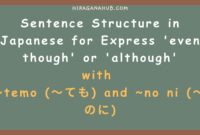In this Japanese grammar lesson, we’ll explore the N5-level pattern ~no naka de… ga ichiban (~の中で…が一番), which means “Among…, … is the most…”. This structure is used to compare items within a group and highlight the top or bottom in a category.
Japanese Grammar Breakdown
Formula:
[Group/Category] + の中で + [Subject] + が + 一番 + [Adjective]
Examples:
日本の季節の中で春が一番好きです。
Nihon no kisetsu no naka de haru ga ichiban suki desu.
Among Japan’s seasons, spring is my favorite.
このレストランのメニューの中で寿司が一番人気です。
Kono resutoran no menyuu no naka de sushi ga ichiban ninki desu.
Among this restaurant’s menu items, sushi is the most popular.
読んだ漫画の中で「ワンピース」が一番面白いです。
Yonda manga no naka de “Wan Piisu” ga ichiban omoshiroi desu.
Among the manga I’ve read, “One Piece” is the most interesting.
スポーツの中でサッカーが一番楽しいです。
Supootsu no naka de sakkaa ga ichiban tanoshii desu.
Among sports, soccer is the most fun.
日本語の試験の中でN5が一番簡単です。
Nihongo no shiken no naka de N5 ga ichiban kantan desu.
Among Japanese language exams, N5 is the easiest.
Usage Notes
- Use ~no naka de to specify the group being compared.
- 一番 (ichiban) always comes before the adjective.
- This structure works with both positive and negative adjectives (e.g., 一番難しい – the most difficult).
Now that you’ve learned this pattern, try making your own sentences! Want to learn Japanese online free? Practice with real-life examples to improve faster.



